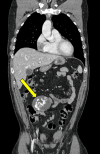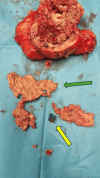Thirty-Five Years of Gossypiboma
- PMID: 41246609
- PMCID: PMC12612790
- DOI: 10.7759/cureus.94478
Thirty-Five Years of Gossypiboma
Abstract
The term gossypiboma refers to a textile matrix object left in a body cavity during surgery. It is often mistaken for other pathologies and symptoms can be very heterogeneous. Retained surgical items often have legal as well as clinical consequences. To reduce the incidence of gossypiboma, safety procedures have been proposed that the surgical team must implement. In case of an occasional finding during another procedure, it is necessary to share the most correct management. The case we present involves a patient in whom an intra-abdominal mass was identified during a laparoscopic cholecystectomy. The initial decision was to perform a biopsy of the mass and postpone the definitive surgery. Histological examination provided the diagnosis of gossypiboma. The patient's medical history revealed that the surgical item had been retained for 35 years. Subsequently, we performed a second operation in which the gossypiboma was removed at the same time as the cholecystectomy.
Keywords: abdominal surgery; general surgery; gossypiboma; retained surgical item; textile matrix.
Copyright © 2025, Passa et al.
Conflict of interest statement
Human subjects: Informed consent for treatment and open access publication was obtained or waived by all participants in this study. Conflicts of interest: In compliance with the ICMJE uniform disclosure form, all authors declare the following: Payment/services info: All authors have declared that no financial support was received from any organization for the submitted work. Financial relationships: All authors have declared that they have no financial relationships at present or within the previous three years with any organizations that might have an interest in the submitted work. Other relationships: All authors have declared that there are no other relationships or activities that could appear to have influenced the submitted work.
Figures




References
-
- Surgical gauze pseudotumor. Serra J, Matias-Guiu X, Calabuig R, Garcia P, Sancho FJ, La Calle JP. Am J Surg. 1988;155:235–237. - PubMed
-
- Risk factors for retained instruments and sponges after surgery. Gawande AA, Studdert DM, Orav EJ, Brennan TA, Zinner MJ. N Engl J Med. 2003;348:229–235. - PubMed
-
- Gossypiboma: tales of lost sponges and lessons learned. McIntyre LK, Jurkovich GJ, Gunn ML, Maier RV. Arch Surg. 2010;145:770–775. - PubMed
Publication types
LinkOut - more resources
Full Text Sources
